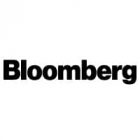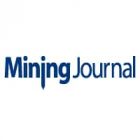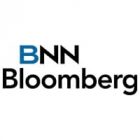Investment Insights. Stay Ahead.
LME explores price premium on sustainable metal production
Subscribe for Investment Insights. Stay Ahead.
Investment market and industry insights delivered to you in real-time.
The London Metal Exchange (LME) has announced a significant step towards recognizing and incentivizing sustainable metal production, as it is currently engaging closely with physical market stakeholders on its proposals for four key metals:
- aluminium
- copper
- nickel
- zinc
The move would have the potential to support a market for sustainably produced metals.
The LME’s proposal, now under consultation, builds on its 2024 partnership with Metalshub, a digital platform that already facilitates price discovery for low-carbon nickel. The new plan would extend this approach to aluminium, copper, nickel, and zinc, using a more comprehensive set of sustainability criteria.
Key features include:
- robust criteria: each metal would be assessed using both a metal-specific carbon footprint methodology and third-party sustainability assurance.
For example, copper would require compliance with the International Copper Association’s methodology and The Copper Mark assurance, while aluminium would follow the International Aluminium Institute’s methodology and the Aluminium Stewardship Initiative standard - LMEpassport integration: metal brands would submit their sustainability credentials via LMEpassport, ensuring transparency and comparability across the market
- independent price administration: ehe LME proposes appointing a pricing administrator to publish the sustainability premia based on Metalshub trading data and expert judgement. Market participants would be able to engage directly with the administrator to raise issues or provide additional data
“Our conversations with stakeholders have shown that there is support for establishing a way to reflect an LME brand’s sustainability in its price. There is a growing sophistication in industry sustainability standards and accreditation programmes that cover broad criteria for different metals markets”
— Matthew Chamberlain, LME CEO
The move is widely seen as a critical development for the metals and mining sector, especially as end-users and investors increasingly seek to support lower-carbon, responsibly sourced materials — and governments look to secure supply outside of cheaper minerals produced by China.
Nick Stansbury, Head of Climate Solutions at L&G Asset Management, welcomed the proposal, saying, ““Transparent pricing of sustainable materials is critical to incentivising investment into transition technologies in the mining industry and we look forward to the outcome of this market engagement process.”
Dr Frank Jackel, Co-Founder and Managing Director of Metalshub, added, “By integrating sustainability data into trading processes, we enable participants to make informed decisions, ensuring that responsible metals receive fair market valuation. Providing the technological foundation for price discovery will help to drive the industry towards a greener and more responsible future.”
The LME is currently engaging with a broad range of market stakeholders and will provide further updates as the proposal develops. If implemented, the sustainable metal premia could become a key tool in driving investment into greener supply chains and supporting the global critical minerals agenda46.
For the mining and investment community, the LME’s move signals a new era where sustainability is not just a reporting metric, but a marketable asset with tangible economic value.
The LME’s proposed sustainability criteria would incorporate both carbon footprint thresholds, calculated with a metal-specific carbon footprint methodology, and a third-party sustainability assurance. The criteria for each metal would be as follows:
Sustainable nickel
- carbon footprint: Nickel Institute methodology
- future third-party sustainability assurance: the LME plans to add the requirement for assurance by The Nickel Mark in the future, but because the existing LME/Metalshub offering is gaining traction as a low-carbon product, it is considered appropriate to respect the original specification, until the industry is ready to embed The Nickel Mark assurance
Sustainable copper
- carbon footprint: International Copper Association methodology
- third-party sustainability assurance: The Copper Mark
Sustainable aluminium
- carbon footprint: International Aluminium Institute methodology
- third-party sustainability assurance: Aluminium Stewardship Initiative Performance Standard
Sustainable zinc
- carbon footprint: International Zinc Association methodology
- third-party sustainability assurance: The Zinc Mark
Our analysis on the challenges and opportunities in the bifucration of prices in the critical minerals market:
Subscribe for Investment Insights. Stay Ahead.
Investment market and industry insights delivered to you in real-time.
Trump launches national security investigation into foreign-controlled critical mineral imports
Subscribe for Investment Insights. Stay Ahead.
Investment market and industry insights delivered to you in real-time.
President Donald Trump has ordered a formal investigation into whether US dependence on foreign-processed critical minerals and the products they feed threatens national security.
The executive order, signed on April 15, 2025, initiated under Section 232 of the Trade Expansion Act, signals another front in the White House’s push to break reliance on hostile foreign supply chains — in particular, China.
“Major global foreign producers of processed critical minerals have engaged in widespread price manipulation, overcapacity, arbitrary export restrictions, and the exploitation of their supply chain dominance to distort world markets and thereby gain geopolitical and economic leverage over the United States”
— Executive Order, Ensuring national security and economic resilience through section 232 actions on processed critical minerals and derivative products
The investigation will determine whether imports of processed critical minerals and their derivative products threaten to impair US national security. The minerals impacted are included in the “Critical Minerals List” published by the United States Geological Survey, as well as uranium.
The US Department of Commerce now has 180 days to deliver a final report with recommendations to the President, which should also consider:
- the imposition of tariffs as well as other import restrictions and their appropriate levels
- safeguards to avoid circumvention and any weakening of the section 232 measures
- policies to incentivize domestic production, processing, and recycling
- any additional measures that may be warranted to mitigate US national security risks
Subscribe for Investment Insights. Stay Ahead.
Investment market and industry insights delivered to you in real-time.
China halts exports of seven rare earths
Subscribe for Investment Insights. Stay Ahead.
Investment market and industry insights delivered to you in real-time.
Exports of rare earths placed under export restrictions from China on April 4 have reportedly “ground to a halt” almost immediately as exporters have been forced to wait for government licence approval.
The impacted rare earths are:
- Samarium
- Gadolinium
- Terbium
- Dysprosium
- Lutetium
- Scandium
- Yttrium
The critical minerals are used across the defense, energy and automotive industries.
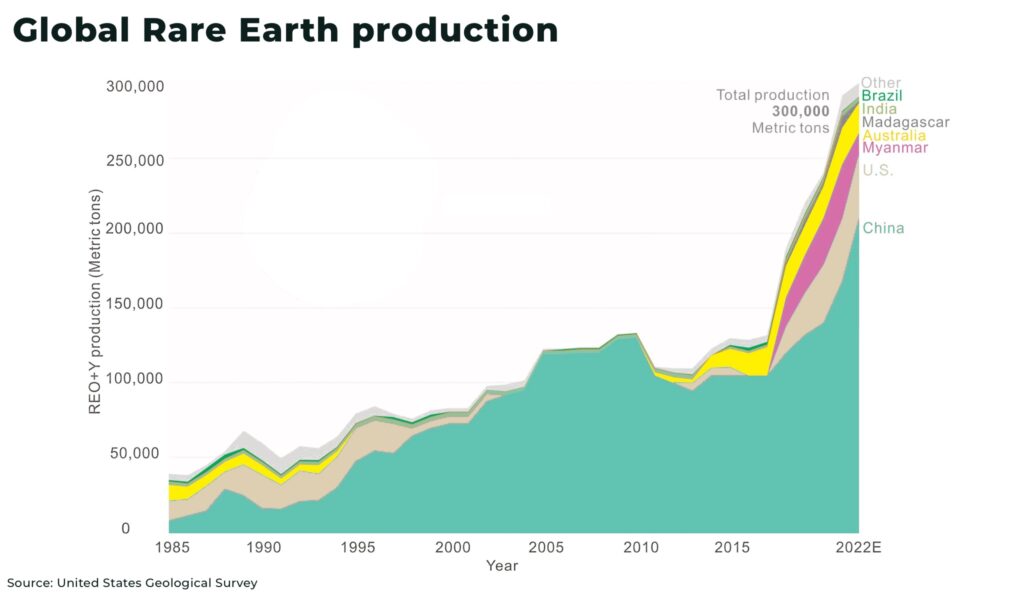
Reuters reports exporters must now apply to China’s Ministry of Commerce for licenses, a process that can months. For example, Reuters reported last month there had been no antimony exports to European Union countries since China put the metal on a control list in September.
The New York Times quotes Michael Silver, the chairman and chief executive of American Elements, a chemicals supplier based in the USA, who said his company had been told it would take 45 days before export licenses could be issued and exports of rare earth metals and magnets would resume. Mr. Silver said that his company had increased its inventory last winter in anticipation of a trade war between the US and China, and could meet its existing contracts while waiting for the licenses — however, companies vary widely in the size of their emergency critical mineral stockpiles.
China dominates the rare earth market: it’s responsible for 70% of global production and nearly 90% of processing of global output, as well as 90% of rare earth element permanent magnet production.
The tariffs are in retaliation against US President Trump’s tariff of up to 145% on imports from China.
AI data centers to drive 2% of global copper demand by 2030
Subscribe for Investment Insights. Stay Ahead.
Investment market and industry insights delivered to you in real-time.
Global demand for critical minerals from data center development is set to rise significantly by 2030, compared to 2024 levels:
- 2% for copper
- 2% for silicon
- 3% for rare earths
- 11% for gallium
According to a new Energy and AI report by the IEA, forecasts “the absolute volumes in 2030 still reach 512 kilotonnes (kt) of copper and 75 kt of silicon, so project developers have good reason to pay attention to supply security.”
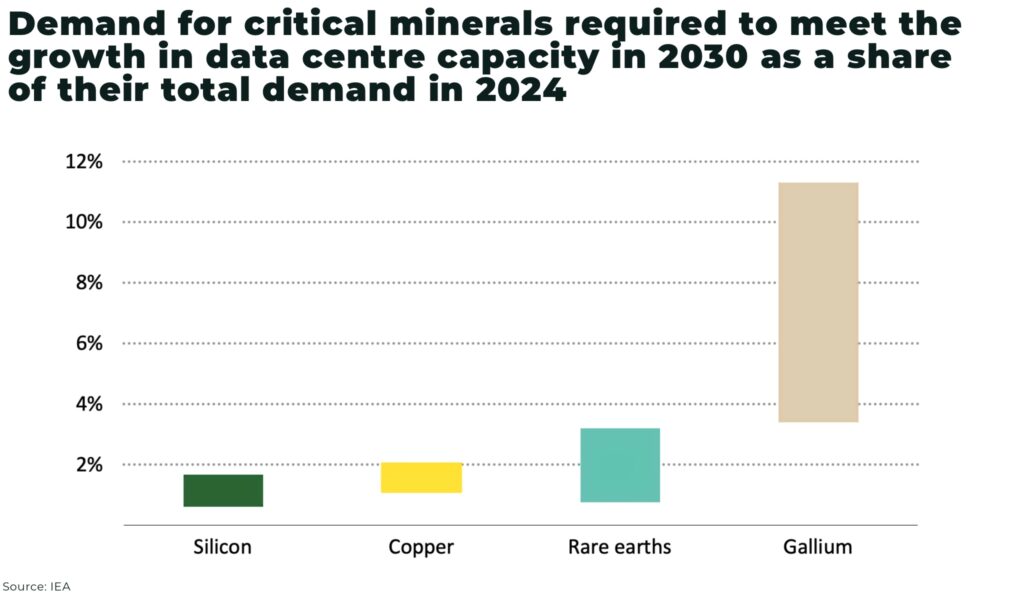
Critical minerals in data centers
Transformers and updated electricity girds are two of the most critical mineral hungry aspects of AI. For example,
- copper and aluminium, as insulation, represents approx 50% of total expense of a transformer
- 20% of cost of a power transformer is grain-orientated electrical steel
Data centers, the backbone of Artificial Intelligence infrastructure, rely on a variety of critical minerals for their construction and operation, including:
- copper: Essential for power distribution systems, networking cables, and cooling infrastructure due to its superior conductivity and durability
- silicon: Used in processors and memory storage components, with ultrapure silicon being a key material for semiconductors
- gallium: Increasingly important for high-efficiency power converters and radio frequency components.
- aluminium: Valued for its lightweight properties and thermal conductivity, it is used in server racks, casings, and cooling systems
- rare earth elements (REEs): Neodymium, praseodymium, dysprosium, and terbium are critical for high-performance magnets in motors, cooling fans, hard drives, and optical components
- battery minerals: lithium-ion batteries in uninterruptible power supplies (UPS) rely on lithium and other battery materials
Supply chain vulnerabilities
The IEA warns geographical concentration of critical mineral production poses significant risks, for example:
- nearly 60% of refined copper comes from just three countries
- over 90% of aluminium, silicon, magnet rare earths, and gallium are sourced from three dominant producers, primarily China
This concentration creates vulnerabilities to supply shocks caused by trade restrictions, extreme weather events, or geopolitical tensions. Recent developments have exacerbated these risks:
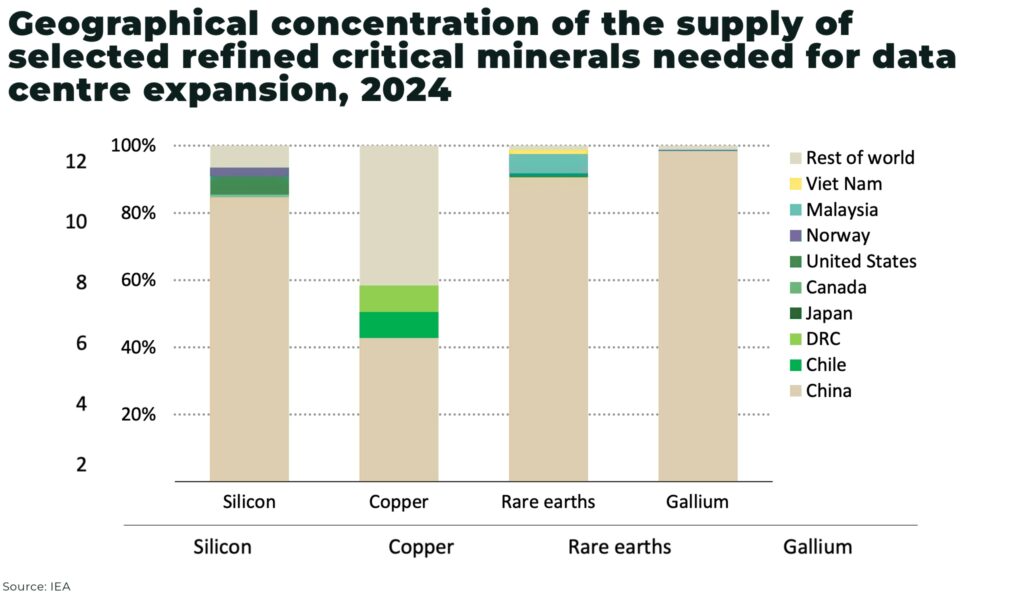
Our recent report on how the explosion of Artificial Intelligence it expected to spark a 10-year critical mineral supercycle as the massive energy needs of new AI data centers will increase pressure on global supply chains already under strain to meet global net-zero targets:
Subscribe for Investment Insights. Stay Ahead.
Investment market and industry insights delivered to you in real-time.
Uranium demand could rise 140% by 2050, according to nuclear agencies
Subscribe for Investment Insights. Stay Ahead.
Investment market and industry insights delivered to you in real-time.
World annual reactor-related uranium requirements are projected to rise to between around 90,000 tU/y and 142,000 tU/y by 2050, from 59,000 tU in 2023 — an increase of 53% and 140% respectively.
According to the latest “Red Book” report by the Nuclear Energy Agency and International Atomic Energy Agency, world nuclear capacity by 2050 is projected to increase from 394 GWe in 2023, to 574 GWe in the low demand case and 900 GWe in the high demand case.
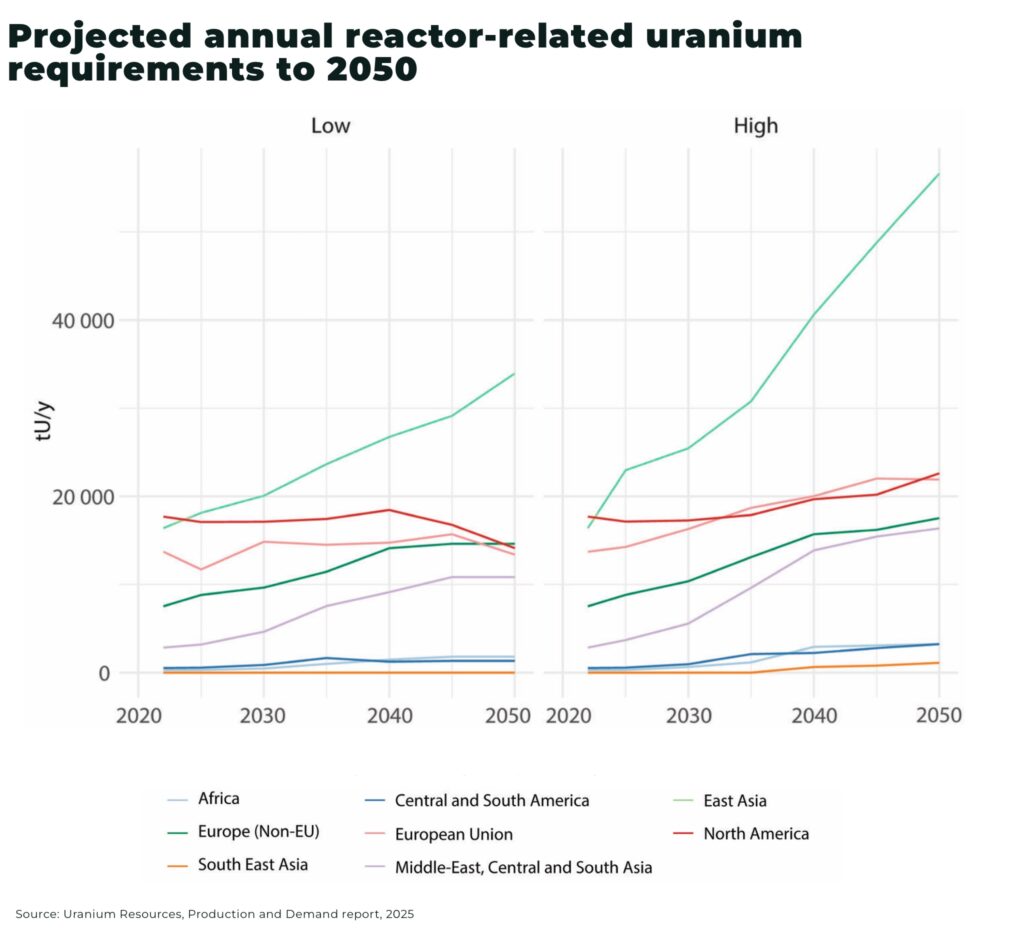
These projections are a significant upward revision of demand projections compared to the 2022 edition of the Red Book.
Asia is projected to have the largest increase, maybe as high as 354 GWe by 2050; however, in the US, in the low case nuclear capacity could decrease 18% or rise 31% in the high demand case.
The report warns that uranium supply will struggle to meet the high-demand growth requirements by the 2080s:
“Meeting high-demand growth requirements by 2050 would use approximately 50% of the currently identified recoverable resource base at costs below USD 130/kgU and about 35% at costs below USD 260/kgU. Beyond 2050, however, even if nuclear capacity remains at 2050 levels, cumulative uranium requirements would surpass 100% of the current total identified resource base in the highest cost category by the 2080s under high demand or by the 2110s under low demand”
— Uranium Resources, Production and Demand, report 2025
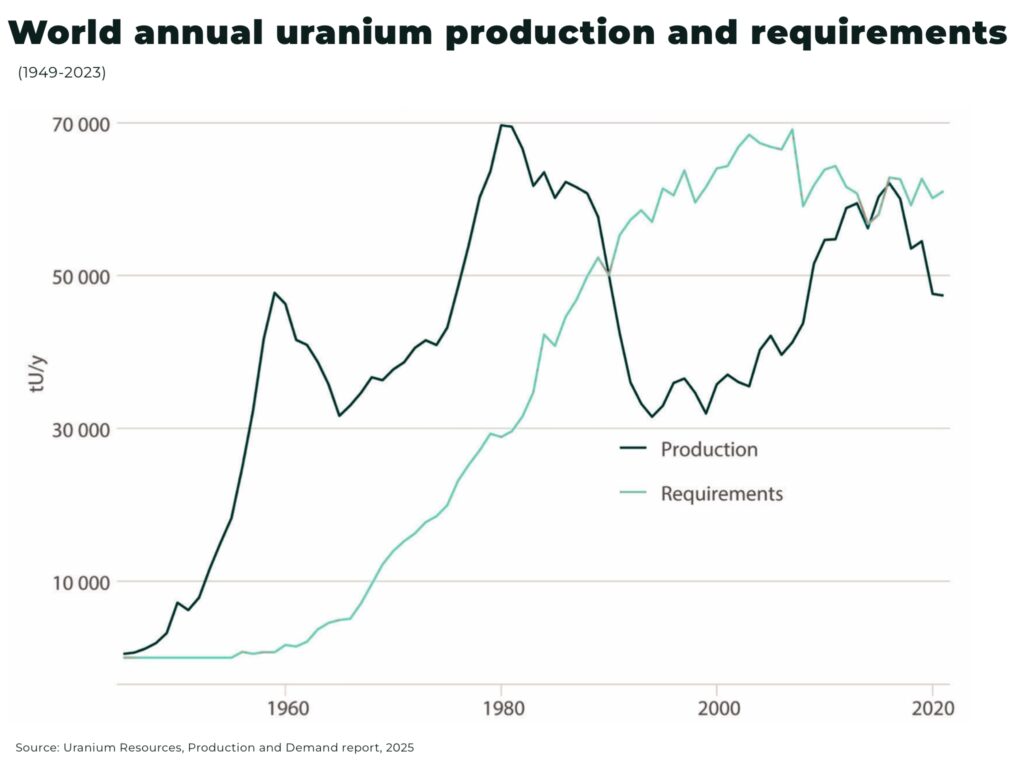
Our report on where new uranium supply will come from:
China announces rare earth export restrictions
Subscribe for Investment Insights. Stay Ahead.
Investment market and industry insights delivered to you in real-time.
China has announced export restrictions on seven rare earth minerals, effective immediately, in response to the recent tariffs by US President Trump. The restrictions include:
- Samarium
- Gadolinium
- Terbium
- Dysprosium
- Lutetium
- Scandium
- Yttrium
The restrictions will impact all countries, not just the US.

China dominates the rare earth market: it’s responsible for 70% of global production and nearly 90% of processing of global output, as well as 90% of rare earth element permanent magnet production.
The export restrictions are in addition to tariffs of 34% on all US goods from April 10. The move comes the day after US President Trump announced a combined total of 54% of imports from China.
“The purpose of the Chinese government’s implementation of export controls on relevant items in accordance with the law is to better safeguard national security and interests, and to fulfil international obligations such as non-proliferation”
— China Commerce Ministry
The ban comes only months after China banned exports of gallium, germanium and antimony to the US.
China halts exports of seven rare earths
AI data centers to drive 2% of global copper demand by 2030
Uranium demand could rise 140% by 2050, according to nuclear agencies
China announces rare earth export restrictions
China’s mining investments under Belt and Road Initiative hit record high in 2024
Subscribe for Investment Insights. Stay Ahead.
Investment market and industry insights delivered to you in real-time.
Investment by China in metals and mining, through its Belt and Road Initiative (BRI), hit new records of US$21.4 billion in 2024, an increase of 10% compared to 2023.
According to a new report by Griffith Asia Institute, the mining sector was the second largest sector with about
17.6% of the BRI overall engagement.
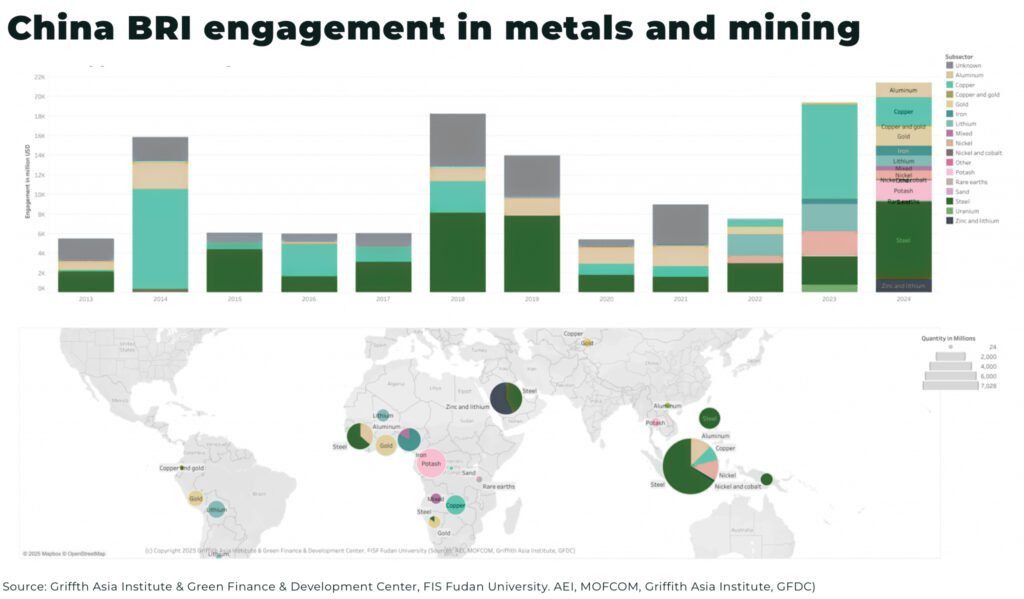
Engagement was particularly focused across West and Central Africa, Bolivia and Chile in Latin America, and Indonesia. Metals and minerals include coal, copper, nickel, cobalt.
When comparing construction and investment in different sectors, the report notes, it becomes clear that in mining and technology, Chinese firms are increasingly prioritizing equity investments, despite the higher risks involved.
For 2025, further stabilization of Chinese BRI engagement is expected with a strong focus on BRI country partnerships in renewable energy, mining and related technologies.
Subscribe for Investment Insights. Stay Ahead.
Investment market and industry insights delivered to you in real-time.
EU approves first 47 projects worth $24 billion to secure critical raw materials supply
Subscribe for Investment Insights. Stay Ahead.
Investment market and industry insights delivered to you in real-time.
The European Commission has officially approved the first 47 strategic projects under the Critical Raw Materials Act (CRMA) to diversify and secure critical mineral supply.
The projects address 14 of the 17 strategic raw materials identified in the CRMA:
- extraction (25 projects)
- processing (24 projects)
- recycling (10 projects)
- and substitution (2 projects)
The primary focus is electric battery metals, green transition, digital transformation, and defense capabilities:
- lithium (22 projects)
- nickel (12 projects)
- graphite (11 projects)
- cobalt (10 projects)
- manganese (7 projects)
- tungsten (3 projects)
- and magnesium (1 project)
The selected projects are across 13 EU member states, include: Belgium, Czechia, Estonia, Finland, France, Germany, Greece, Italy, Poland, Portugal, Romania, Spain, and Sweden – represent a total investment of nearly US$24 billion, or €22.5 billion.
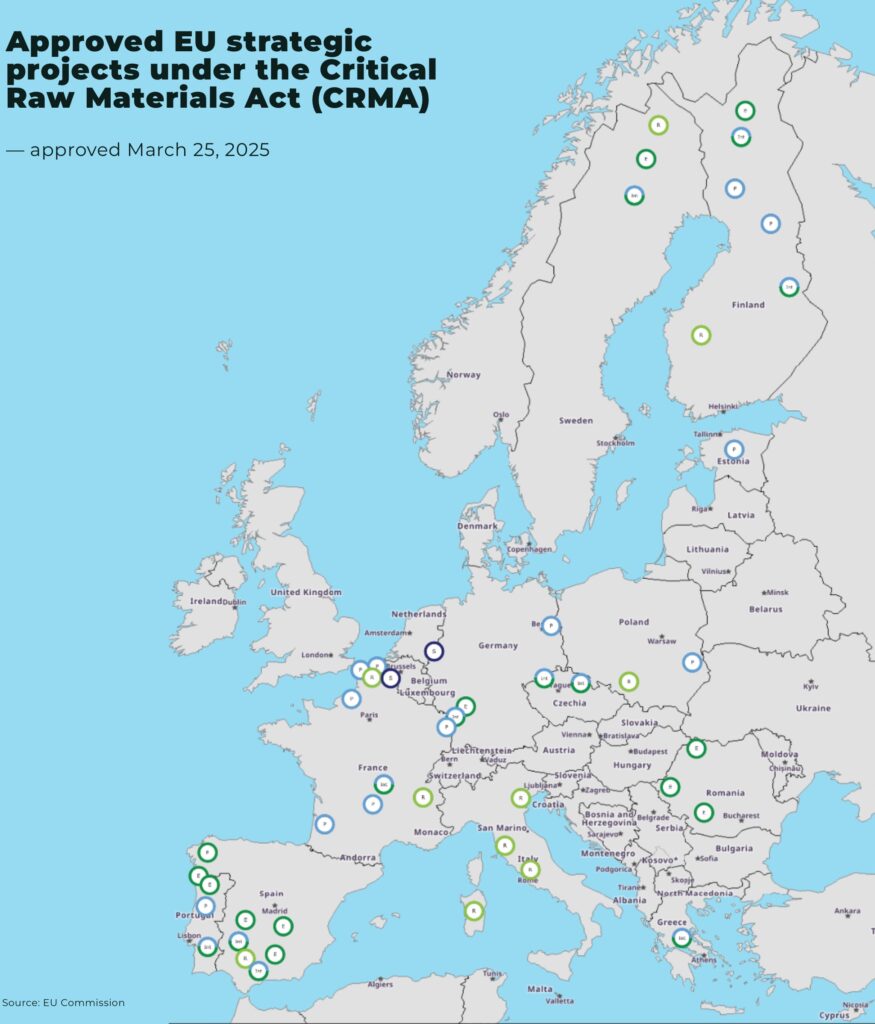
Streamlined permitting and coordinated support
To expedite the operationalization of these projects, the EU Commission, Member States, and financial institutions will provide coordinated support, particularly in facilitating access to finance and connecting project promoters with relevant off-takers.
Furthermore, the projects will benefit from streamlined permitting processes, ensuring predictability for investors while upholding stringent environmental, social, and governance (ESG) standards. Extraction projects will be subject to a permit-granting process not exceeding 27 months, while other projects will have a 15-month limit, in accordance with the CRMA.
Key strategic projects
The approved projects showcase a diverse range of initiatives across the EU. Highlights include:
- Ageli (France): an integrated lithium extraction and processing project by Eramet aimed at supplying battery-grade lithium
- Barroso Lithium Project (Portugal): a lithium extraction project by Savannah Lithium focused on battery-grade lithium
- Chvaletice Manganese Project (Czechia): an integrated manganese extraction and processing project by Euro Manganese Inc targeting battery-grade manganese
- NorthCYCLE (Sweden): a recycling project by Northvolt Revolt AB recovering manganese, lithium, graphite, nickel, and cobalt from batteries
- Verde Magnesium (Romania): a magnesium extraction project by Verde Magnesium SRL aimed at supplying magnesium metal
Our analysis on how Europe is struggling to avoid another geopolitical disaster, this time over critical minerals:
Subscribe for Investment Insights. Stay Ahead.
Investment market and industry insights delivered to you in real-time.
Canada streamlines approval process for major mining and infrastructure projects
Subscribe for Investment Insights. Stay Ahead.
Investment market and industry insights delivered to you in real-time.
Canada’s provinces and territories will be permitted to approve major mining and infrastructure projects — and will no longer require separate federal government reviews, in a sweeping reform to streamline project development in Canada.
Canadian Prime Minister Mark Carney announced the new “one project, one review” policy after meeting with the country’s 13 premiers, with the aim to eliminate duplicate, bureaucratic requirements.
“We will eliminate federal duplicative requirements by recognizing provincial assessments for major projects, the so-called mutual recognition… So, one project, one review, and we will work with the provinces and other stakeholders, Indigenous groups, to identify projects of national significance and accelerate the time frame to build them”
— Mark Carney, Canadian Prime Minister, told reporters in Ottawa
The government initiative extends beyond the mining sector, with Prime Minister Carney also announcing plans to remove all inter-provincial trade barriers by July 1, 2025, a move estimated to unlock C$250 billion in annual economic impact.
Key projects included in the announcement
- Cedar LNG Project: a C$5.8 billion Indigenous-led liquefied natural gas export facility near Kitimat, British Columbia, has been identified as a leading candidate for this expedited process
- Ring of Fire development: the critical minerals-rich region in northwestern Ontario is slated for quick approval under this new framework
- First Mile Fund: a new capital fund will be established to finance the construction of transmission and transportation networks linking extraction sites to existing infrastructure
- LEENSF: the Large Enterprise Economic and National Security Facility will be overseen by the Finance Ministry to provide liquidity support and funding for regional development agencies
Implications for the mining sector
This policy shift is poised to have far-reaching effects on Canada’s mining industry. By reducing regulatory overlap and streamlining the approval process, the government aims to create a more attractive environment for investment in resource extraction and critical minerals development.
The focus on critical minerals, particularly in the Ring of Fire region, aligns with global demand for materials essential to clean energy technologies and advanced manufacturing. This could position Canada as a key player in the supply chains for electric vehicles, renewable energy infrastructure, and other high-tech industries.
Additionally, the cancellation of planned increases to the capital gains tax and the consumer carbon tax signals a shift towards policies aimed at stimulating economic growth and investment across mining and the economy as a whole.
Upcoming election
The new announcements come as Canada prepares for a federal election, and although an election can throw everything “up in the air”, we suspect that — whoever wins, the fact this has been agreed by the Liberal party with all the Premiers — will mean this will now be long-term federal policy.
Our analysis on plugging Canada’s miners into America’s battery belt:
Subscribe for Investment Insights. Stay Ahead.
Investment market and industry insights delivered to you in real-time.
China ramps up state investment in critical minerals as US trade tensions intensify
Subscribe for Investment Insights. Stay Ahead.
Investment market and industry insights delivered to you in real-time.
The Chinese government has raised more than US$13.8bn (Rmb100bn) investment across geological exploration annually since 2022, the highest three-year period in a decade.
According to a new report by the Financial Times, over the past year, at least half of China’s 34 provincial-level governments have announced increased subsidies or expanded access for mineral exploration. This include key resource-producing regions such as Xinjiang, which has increased support for geological exploration from 150 million yuan in 2023 to 650 million yuan in 2025.

The boost in state funding and subsidies for mineral exploration and mining comes as part of President Xi Jinping’s strategy for China achieve self-sufficiency, as well as provide further leverage in the escalating trade war with the United States.
Beijing recently tightened control over exports of strategic minerals crucial for modern tech and chip manufacturing, including gallium, germanium, antimony, graphite, and tungsten. This move came in response to US restrictions on tech exports to China.
China dominates mining and processing across the majority of critical minerals — with the country being the world’s largest producer of 30 out of 44 critical minerals tracked by the US Geological Survey. This includes a 95% share in rare earths production, 83% in gallium, and 81% in tungsten.
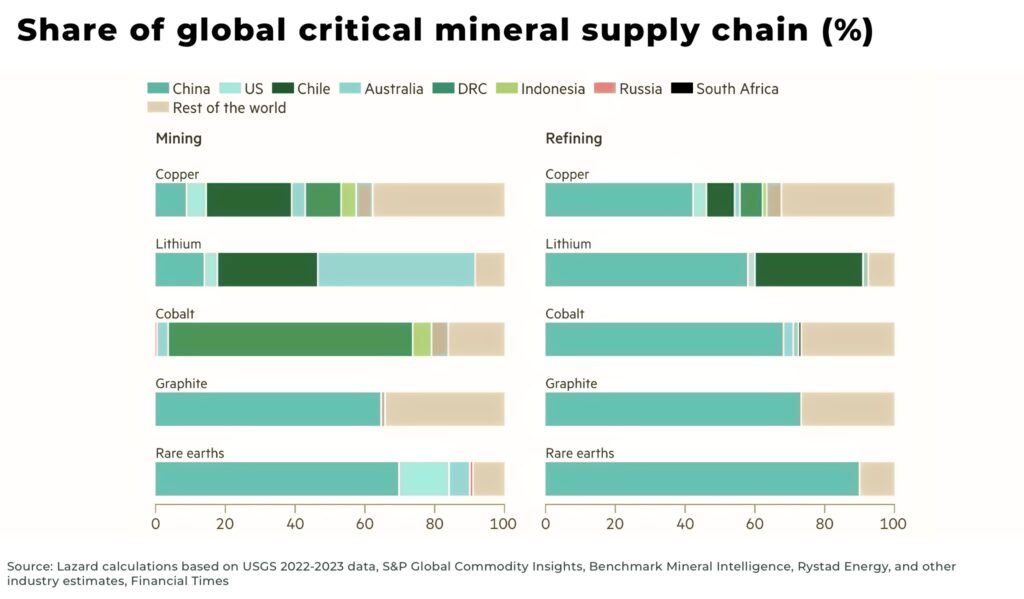
Other measures taken by China include:
- the Chinese government has allocated over US$13.8 billion (100 billion yuan) annually to geological exploration since 2022, marking the highest three-year investment period in a decade
- Xinjiang, a resource-rich western region, has significantly increased the issuance of mining exploration rights to record levels
- China has issued US$57 billion in loans over two decades via at least 26 state-backed financial institutions
- under Xi’s leadership, Beijing has implemented policies to protect its strategic resources. In 2021, China blocked foreign companies from investing, even indirectly, in mining tungsten, rare earths, and uranium
Of the 50 mineral commodities identified in the US Geological Society’s “2022 Final List of Critical Minerals,” the US was 100% net import reliant for 12, unchanged from 2023, and an additional 28 (down from 29 in 2023) had a net import reliance of greater than 50%.
In response to China’s supply chain dominance, US President Donald Trump, since his return to the White House in January, has prioritized domestic mining. In March 2025, he signed a new Executive Order invoking cold war era powers to ramp up critical mineral production across the US.
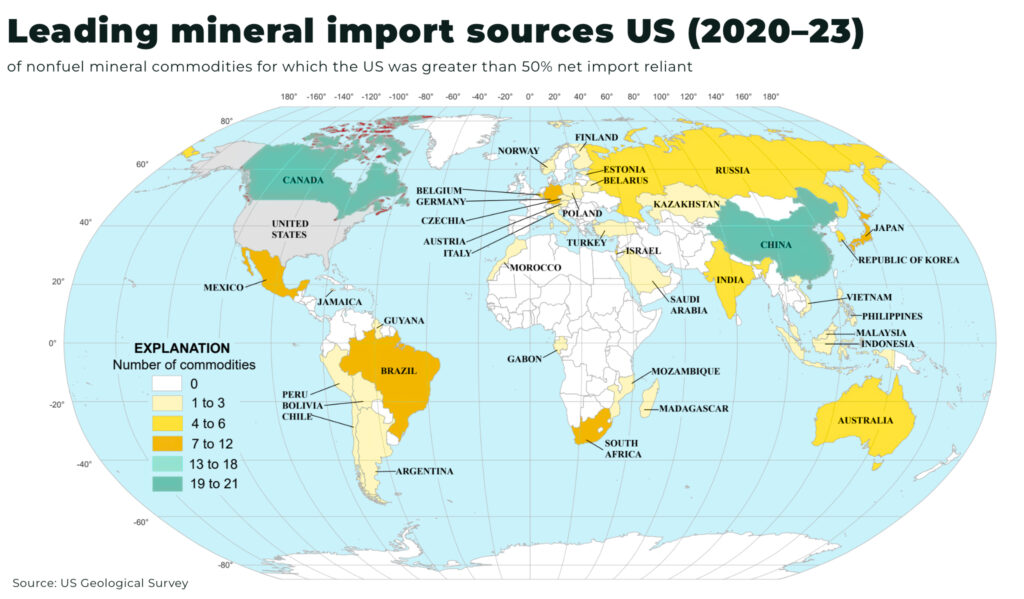
Our analysis on the challenges for American’s current critical mineral strategy:
Subscribe for Investment Insights. Stay Ahead.
Investment market and industry insights delivered to you in real-time.
